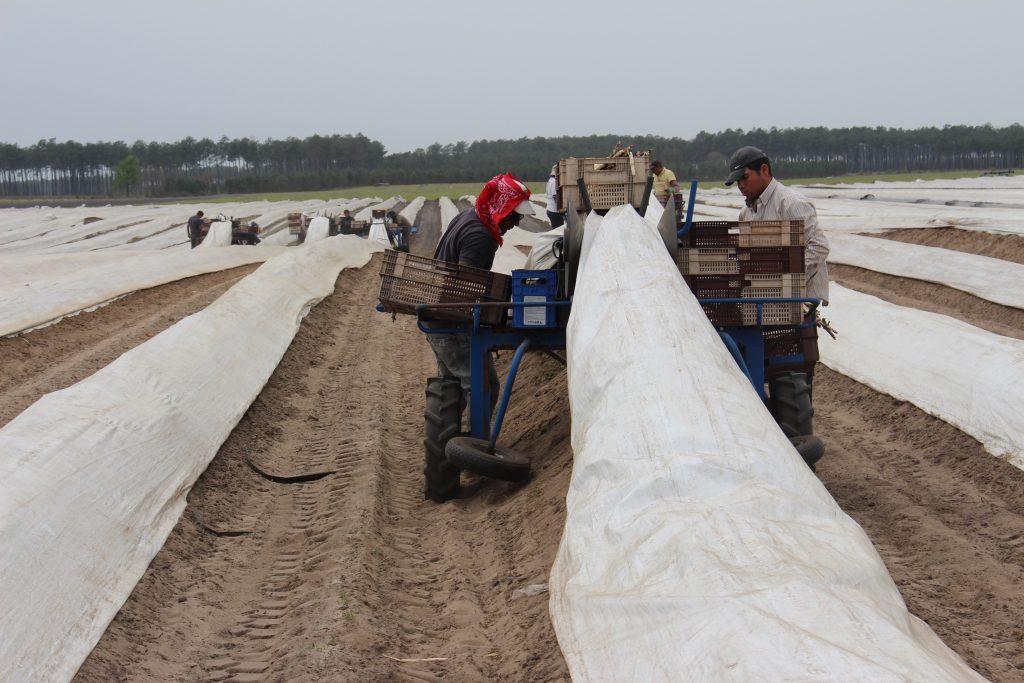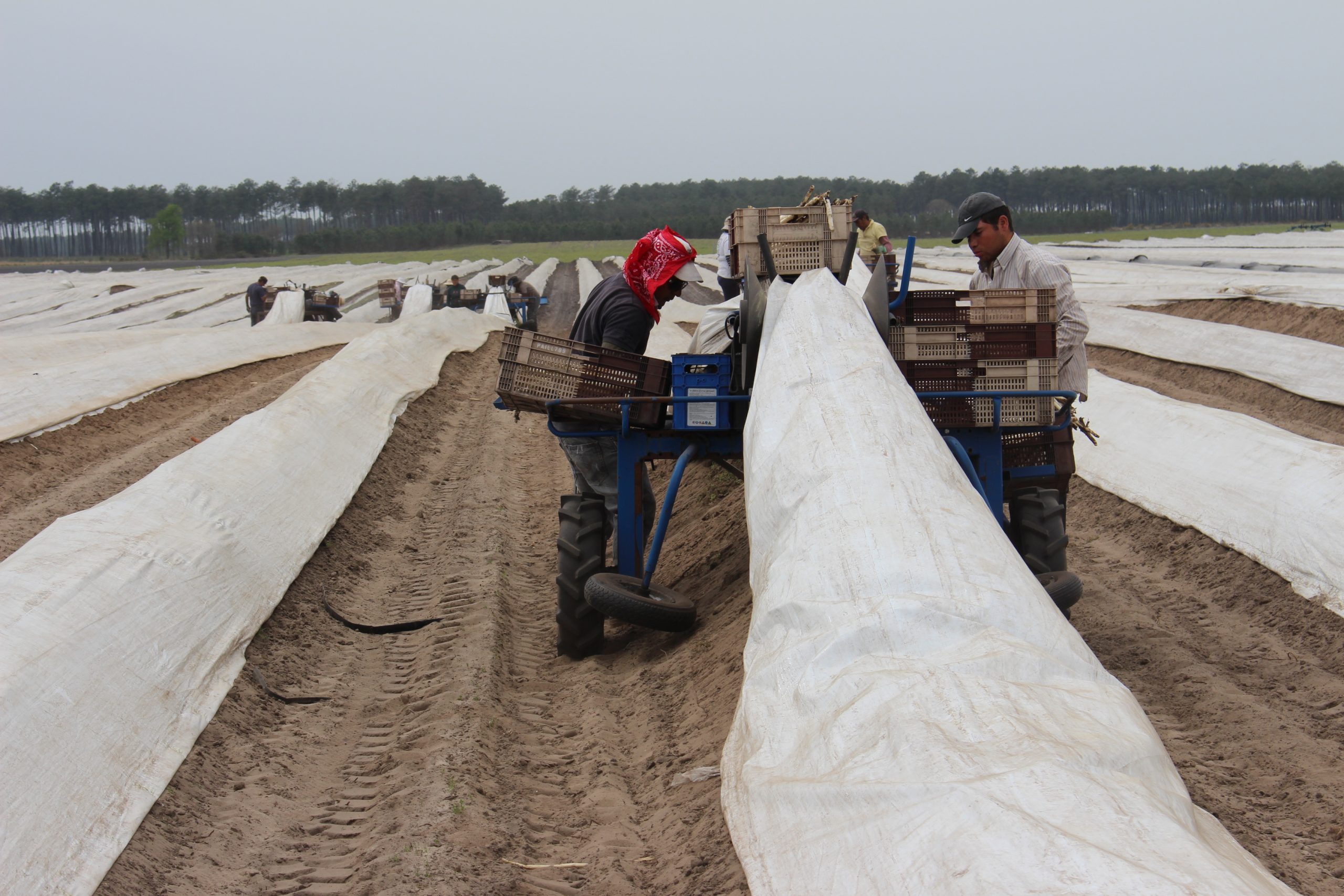France cultivates tradition
Over 20,000 tons of asparagus is produced in France each year; according to Eurostat, output reached 20,680 tons in 2018 and 21,600 tons in 2017. Asparagus is part of France’s agricultural and gastronomic culture.
Producers’ great technical expertise
For producers and consumers alike, asparagus has now become an established part of the heritage of many French regions. It used to be grown only in the south of country, because asparagus is a Mediterranean plant, but the kings of France also tasted asparagus from the Loire Valley. The variety Asparagus d’Argenteuil (a city near Paris) won awards in 1878 at the Universal Exhibition in Paris. Asparagus has been grown in many parts of France such as the Loire Valley, Languedoc, Aquitaine and Alsace. In the 1960s, asparagus developed in the south-east of France alongside its vines. This is an early harvesting area thanks to its warm spring climate. But fusariasis has largely decimated this culture. In the 1980s, French production found refuge in the sandy lands of the Landes on the ocean front. New soils and especially the development of the use of plastic films have allowed the south-west of France to become the country’s leading asparagus production area, with almost 25% of the surface.
The climatic issues presented by the south-western region have been overcome by a winning combination of the producers’ high level of technical knowhow, early planting of varieties, and the use of multi-film coverage. This year, the first French asparagus was harvested in early February in the Landes. French asparagus has long been in competition with Spanish asparagus, which is always earlier and often cheaper on the French market, with the extra cost of transport offset by the lower labour costs in Spain. With the drop in the production of Spanish white asparagus (now converted to green), French asparagus has regained its domestic market. Demand for French asparagus and consumer interest in direct selling boosted plantations and replanting in all production basins between 2014 and 2018, with about 5,000 ha now in France. The asparagus grown in the south-west is mainly intended for large-scale distribution (hyper markets, hard-discounters). The region has two producer groups, Coopadax and Maïsadour, associated with Primeurs de France (formerly Prim’co) for marketing. It also has large independent producers. The region has been recognised as a PGI (protected geographical identification) “Asperges des Landes” since 2005, which brings together 2,500 tons of asparagus from 60 producers. Further north, the Blayais region has also benefited from the “Aperges du Blayais” PGI since 2016.
Standing out from a taste point of view
The Val de Loire is another developing region. In Maine et Loire, asparagus growers, consolidated in the Fleuron d’Anjou cooperative, have specialised and increased their production area. There is also production in the Loir-et-Cher region, where the cultivation of green asparagus is organised within the Axéréal cooperative.
In Languedoc too, asparagus has regained some momentum, with new green asparagus plantations (accounting for a third of the 2017 and 2018 plantations). Green asparagus is often produced by specialised producers under shelters (some heated) and in mini-tunnels to achieve high quality levels. The Camargue is another asparagus area with light, sandy and sometimes salty soils that make for a production with a very different taste quality. The Cofruid’oc cooperative highlights this quality with the “Celestin” brand of white asparagus and “Wild” brand of green asparagus. Alsace has also planted asparagus. Producers there have developed the use of a double mulch (black/white mulch + thermal mulch) to make gains of a few days in terms of precocity while also benefiting final yields. Alsace asparagus is consumed in the region, with more than 70% of the volume going to direct sale. The asparagus is generally peeled at the time of sale, as is also the case in Germany.
Potential for growth in consumption
The highly favourable technical and commercial environment enjoyed by French asparagus over the past ten years is now starting to shift. However, asparagus consumption can be promoted through packaging innovations such as flow packs to improve shelf life, or peeled asparagus to offer greater convenience, or green (and purple) asparagus for greater product innovation. The French asparagus sector can also play the “natural” card with consumers who care about their health, and the “local” card with consumers who want to buy locally. Increased volumes, an extended production schedule, and marketing campaigns can also create opportunities for openings in Europe, as well as in markets further afield thanks to improved conservation techniques and logistics. But 2020 will be a year marked by the Covid-19 crisis, which is hitting the countryside and the consumption of asparagus in France.
More Info
Asparagus Associations
Asparagus accounts for only 2% of France’s vegetable production area, but the place it occupies in the country’s heart is much larger. For consumers, it is the first vegetable of spring. For professionals, asparagus is a high-tech culture that requires great financial investment and management of labour resources, and one which can offer good profitability (depending on the year). In commercial terms, asparagus is a high-end vegetable, with (often) comfortable margins. Asparagus is a vegetable that is grouped within the Association of Asparagus Producers’ Organisations of France. The association consists of seven groups, representing a combined 1,100 ha and 5,300 tons of asparagus – or about 30% of overall production (2019 data). Its missions are to study production and markets, to develop consumption, to respond to production problems (agronomy, crop protection, etc.) and to be the producers’ representative in dealings with the government and administrations. Other independent producers are also grouped within the association Asperge Avenir, while organic asparagus producers have formed an association of their own. These two structures together account for about 30% of French production.
More Info
How to get young people to eat asparagus?
Around 81% of asparagus eaten in France is consumed by people over the age of 50, with only 5% eaten by the under 35s. This has led the French asparagus association “Asperges de France” to carry out a study to encourage young adults to consume more. The results show that under 35s tend to buy asparagus because it is a vegetable that “celebrates the arrival of spring”, which is “rare and seasonal”, and which is “fun”. The reasons they don’t buy it are because “it’s not on the shelf,” “it’s expensive”, or “it’s not good quality”. The majority of young people buy bunches because they are “fast, practical and aesthetic”. They love novelty and new uses like green asparagus. 71% of them are inspired by a dish they have eaten in a restaurant to prepare a meal at home. But asparagus is almost never seen on restaurant menus in France!























